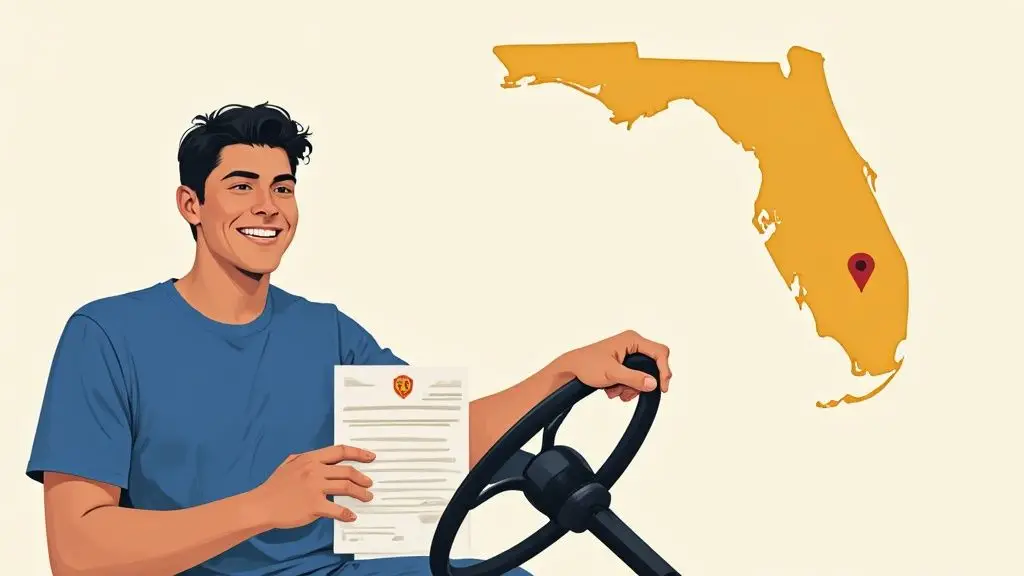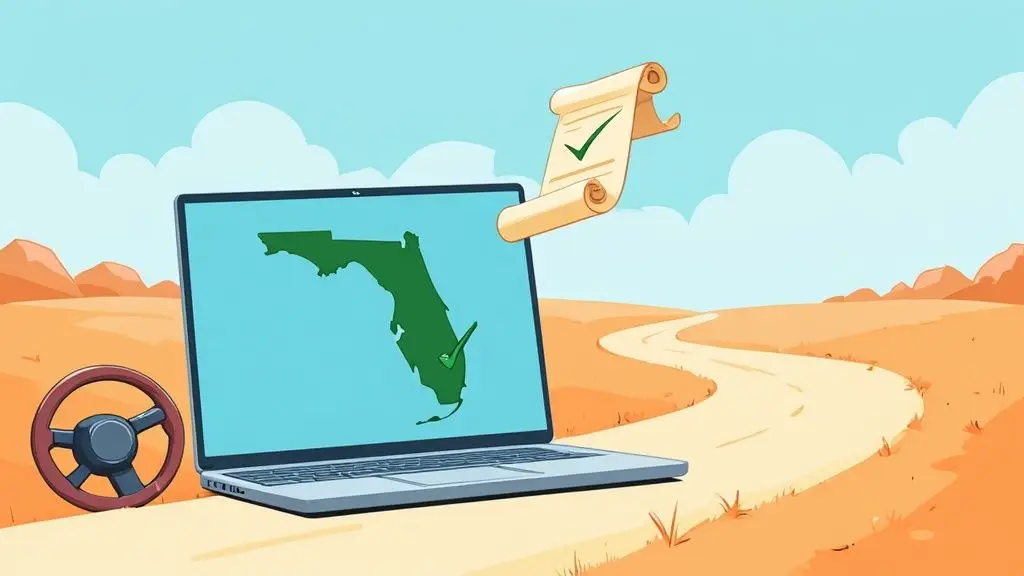Rainy weather can turn familiar roads into dangerous places. The chance of a traffic collision goes up a lot in wet conditions. You will have a harder time seeing, and the roads will be slippery. The risk of hydroplaning is also very real. Driving in the rain means you need to change how you drive.
Learning to drive in wet weather is about being ready. It helps to understand how your car works on a wet road. For example, your tires need to grip the pavement. This guide gives you the most important tips for safe driving in the rain. It covers slowing down, leaving more space, and what to do if you hydroplane.
By using these defensive driving techniques, you can drive in the rain with more confidence. The goal is to make a stressful drive safer. This article will show you simple ways to stay safe when it rains. You will learn practical steps to see better, control your car, and avoid common dangers.
1. Slow Down and Increase Your Following Distance
Slowing down is the most important thing you can do when driving in the rain. Wet roads change how your car handles. They reduce your tire grip and make it take longer to stop. Even a little rain can mix with oil on the road. This creates a slick surface that is hard to drive on. According to the Federal Highway Administration (FHWA), rain is a major weather-related cause of crashes.

This rule is not just for new drivers. Even professional race car drivers slow down by 20-30% on a wet track. In addition, many trucking companies have rules that make their drivers slow down when it rains. These examples show that speed is a very important factor for safety in wet weather. A lower speed gives you more time to react to hazards.
The Six-Second Rule
The normal “three-second rule” for following distance is not enough in the rain. Consequently, you should double it to at least six seconds. This gives you enough time to brake safely if the car in front of you stops quickly.
To check your following distance, watch the car ahead pass a fixed object like a sign. Then, start counting “one-one-thousand, two-one-thousand,” and so on. If you pass the same object before you count to six, you are too close.
Failing to slow down can have serious results. Drivers should know that police can give you a ticket for driving too fast for conditions, even if you are below the speed limit. The National Highway Traffic Safety Administration (NHTSA) notes that speeding is a factor in many fatal crashes each year.
Tips for Safe Speed Management
- Make Gradual Changes: Do not speed up or slow down suddenly. Gently press the gas and brake pedals.
- Slow Down for Turns: Start to slow down before you get to a curve, not while you are in it. This helps your car stay stable.
- Check Your Speed: The sound of rain can make it hard to know how fast you are going. Look at your speedometer more often.
- Create More Space: Besides leaving more room in front, try to keep a bigger space cushion on all sides of your vehicle.
By slowing down and leaving more space, you give yourself more time and distance. These are the two most important things for staying safe in the rain.
2. Check Your Tires and Vehicle Maintenance
Your tires are the only part of your car that touch the road. Their condition is very important for safe driving in the rain. Tire tread has deep grooves to push water away from the tire. This helps the rubber stay in contact with the road. If the tread is worn, it cannot move water away well. This can lead to hydroplaning, where your tires lose all contact with the road.
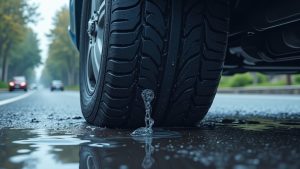
Good tires are a focus in high-stakes driving. For example, Formula 1 race cars use special rain tires with very deep grooves. These tires help prevent hydroplaning at very high speeds. Similarly, airlines have strict rules to check tire tread before every flight for safety. These examples show how important good tires are for controlling a vehicle in the rain.
The Penny Test for Tire Tread
You can check your tire tread easily at home with the “penny test.” This quick check tells you if your tires are safe for wet roads. Ignoring this simple check can put you in danger.
To do the penny test, put a penny with Lincoln’s head upside down in the tire tread. If you can see the top of his head, your tread is too low. It is less than 2/32 of an inch. You should replace the tire right away. The NHTSA offers more tire safety tips for all drivers.
Proper care is more than just tread depth. For example, you also need to check tire pressure. This ensures they perform their best in bad weather. For more detailed vehicle safety information, visit your state’s official transportation website.
Tips for Tire Maintenance
- Check Tire Pressure: Use a pressure gauge to check your tires each month when they are cold. Correct pressure helps the tire make good contact with the road.
- Rotate Your Tires: You should rotate your tires about every 6,000 miles. This helps them wear evenly and last longer.
- Look for Damage: Check your tires for cuts, bulges, or punctures that could cause a blowout.
- Think About Your Climate: If you live where it rains a lot, consider getting all-season or rain-specific tires for better grip.
3. Use Your Headlights for Visibility
Rain makes it hard for everyone to see. Using your headlights is one of the most important tips for safe driving in the rain. It helps you see the road, and it helps other drivers see you. A grey car on a rainy day can be hard to see. But bright headlights help you stand out and can prevent a traffic incident.
This is not just a good idea; it is the law in many places. In Florida, the law says you must turn on your headlights if your windshield wipers are on. You can find this rule in Florida Statutes, section 316.217. These laws exist because being seen is just as important as seeing.
More Than Just Turning Them On
Good visibility means more than just using your headlights. You must also make sure your entire visibility system works well. This includes your windshield wipers and the headlight lenses. Over time, headlight lenses can get yellow or cloudy, which makes them less bright.
A common error is to rely on daytime running lights. These lights are on the front of your car but often do not turn on your tail lights. This makes your car very hard to see from behind. Always turn your headlights to the “On” position in the rain.
Maintaining your lights and glass is a smart safety step. The Insurance Institute for Highway Safety (IIHS) has found that better headlights can prevent many crashes.
Tips for Maximum Visibility
- Replace Wiper Blades: Replace your wiper blades every 6 to 12 months. Change them sooner if they leave streaks on your windshield.
- Clean All Glass: Clean your windshield, windows, and mirrors inside and out. Dirt on the inside of the glass can cause glare and make it hard to see.
- Use Anti-Fog Products: An anti-fog spray on the inside of your windshield can help. A rain-repellent product on the outside helps water roll off faster.
- Check All Lights: Walk around your car to make sure all lights work. This includes headlights, tail lights, brake lights, and turn signals.
4. Avoid Sudden Moves and Be Smooth
Sudden movements are very dangerous on wet roads. When the road is slick, it is easy to lose grip. A sharp turn, hard braking, or quick acceleration can cause a skid. This can lead to a complete loss of control. Therefore, practicing smooth, careful movements is one of the best tips for safe driving in the rain.
This idea is a key part of advanced driver training. For instance, professional driving schools teach drivers to be smooth to get the best traction. Also, emergency vehicle drivers get special training to handle their vehicles smoothly in bad weather. This shows that careful control is a key to safety for everyone.
The “Squeeze and Ease” Method
The goal is to keep the car balanced. Instead of pushing pedals hard, think about squeezing them gently. This works for the gas pedal, the brake, and the steering wheel. As a result, your tires will have the best chance to grip the wet road.
Imagine a string connects your steering wheel and pedals. If you pull one part too hard, it will upset the others. The idea is to make all your movements gentle so the car stays stable.
This careful driving is a basic part of defensive driving. By being smooth, you are always ready for the next move. This could be a turn, a stop, or a lane change. The Governors Highway Safety Association (GHSA) provides resources on how speed management and smooth driving contribute to overall road safety.
Tips for Smooth Vehicle Control
- Gentle Acceleration: When you start moving, press the gas pedal lightly to avoid spinning the wheels.
- Progressive Braking: Squeeze the brake pedal gently at first. Then, add more pressure as you need it. This helps prevent the wheels from locking.
- Deliberate Steering: Guide the car through turns with slow, steady hand movements. Avoid sharp turns of the wheel.
- Plan Ahead: Look far down the road. This helps you see when you need to change lanes or stop, giving you plenty of time to do it smoothly.
5. Avoid Standing Water and Flooded Areas
Puddles on the road can be very dangerous. A puddle might look shallow, but it can hide deep potholes or debris. Avoiding them is one of the most important tips for safe driving in the rain. Even a little bit of water can make you lose control of your vehicle.
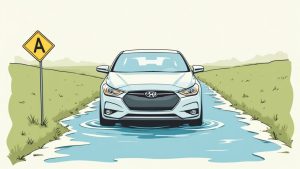
Emergency services strongly warn drivers about this. For example, the National Weather Service has a campaign called “Turn Around, Don’t Drown®”. It highlights the dangers of driving through floods. According to the Federal Emergency Management Agency (FEMA), just six inches of water can cause you to lose control. Twelve inches of water can float many cars. Two feet of moving water can carry away most vehicles.
Assess the Situation and Avoid Water
The safest choice is always to avoid driving through standing water. It is very hard to know how deep it is from your car. If you see a flooded road, find another way to go.
Your car’s engine can be destroyed if water gets into the air intake. This is called hydrolocking. It can happen in shallow water and can be very expensive to fix.
Driving through flooded areas is a risk to your vehicle and your safety. In Florida, some roads are known to flood during heavy rain. The Florida Division of Emergency Management provides safety information and alerts about flooding.
Tips for Handling Water on the Road
- Never Drive Through Moving Water: Flowing water is very powerful. You cannot see the road under it or know how strong the current is.
- Slow Down: If you must drive through a small puddle, slow down to a crawl. Then, proceed with caution.
- Drive in the Middle: Roads are often highest in the center. Driving in the middle may be the shallowest path.
- Test Your Brakes: After you leave the water, tap your brakes gently a few times. This helps to dry them off. Wet brakes do not work as well.
By being cautious around every puddle, you can protect yourself and your car from hidden dangers.
6. Understand and Recover from Hydroplaning
Hydroplaning is when a layer of water gets between your tires and the road. This causes a total loss of traction. Your car can feel like it is sliding on ice. Steering and braking will not work. Knowing how to prevent hydroplaning and what to do if it happens is a vital skill for driving in the rain.
This is such a serious issue that professionals train for it. For instance, airline pilots learn how hydroplaning affects a large plane when it lands on a wet runway. Also, motorcycle safety courses teach riders how to recover from a loss of traction in the rain. These examples show that learning to handle hydroplaning is a key safety skill.
How to Regain Control Calmly
Your first reaction during hydroplaning might be the wrong one. Slamming on the brakes or turning the wheel sharply will make things worse. The right way to respond is to stay calm and let the car get its grip back.
The most important step is to take your foot off the gas pedal right away. Do not brake. This lets the car slow down on its own. It gives the tires a chance to push through the water and touch the road again.
This infographic shows the three steps to recover from hydroplaning safely.
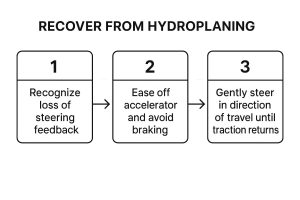
As the diagram shows, the recovery process focuses on slowing down slowly and making small steering movements. This helps traction return naturally.
Tips for Hydroplaning Recovery
- Ease Off the Gas: As soon as you feel the steering get light, take your foot off the gas pedal smoothly.
- Do Not Brake: Fight the urge to hit the brakes. This can lock the wheels and cause you to lose all control.
- Steer Gently: Look where you want to go and make very small steering changes in that direction. Keep the wheels pointed straight if you can.
- Wait for Traction: Be patient. You will feel the tires connect with the road again as the car slows. Once you have control, you can gently brake or steer as needed.
Frequently Asked Questions About Driving in the Rain
1. What is the most important tip for driving in the rain?
The single most important tip is to slow down. Reducing your speed gives you more time to react to hazards and helps prevent hydroplaning. It is the foundation for all other wet-weather safety techniques.
2. How much following distance should I leave in the rain?
You should double the normal following distance. Instead of the usual three-second rule, use a six-second rule. This provides a safer buffer for braking on slick roads, where stopping distances are much longer.
3. When should I use my headlights in the rain?
You should turn on your headlights any time it is raining, no matter the time of day. Many states, including Florida, have “wipers on, lights on” laws that require it. Headlights help other drivers see you, which is just as important as helping you see the road.
4. What should I do if my car starts to hydroplane?
If you start to hydroplane, stay calm. Take your foot off the accelerator and do not slam on the brakes. Steer gently in the direction you want to go. Allow the vehicle to slow down on its own until you feel the tires regain traction.
5. Is it safe to use cruise control in the rain?
No, you should never use cruise control in rainy or wet conditions. If your car hydroplanes while cruise control is on, it may try to accelerate, making the situation worse. You need to be in complete control of your speed at all times.
Your Next Steps Toward Safer Driving
Driving on wet roads does not have to be a scary event. Becoming a safe, confident driver in the rain comes from preparation, awareness, and careful action. By learning the strategies in this article, you can turn panic into control. It starts before you even get in the car, by checking your tires and wipers to make sure your vehicle is ready.
On the road, the most important changes are about space and speed. Slowing down gives you more time to react. Leaving more space gives you the room you need to stop safely on wet pavement. These two steps alone can greatly lower your risk. In addition, learning to be smooth with your steering, braking, and acceleration helps prevent a loss of control. Each of these tips for safe driving in the rain work together to keep you safe.
Ultimately, the goal is to make these safe habits automatic. Think of it as building muscle memory for driving. Understanding hydroplaning turns a scary event into a problem you know how to solve. Turning on your headlights is not just a nice idea; it is a vital way to communicate with other drivers.
These are not just ideas; they are skills you can use every time it rains. The real value comes from using them on every trip. Every safe drive in the rain makes these good habits stronger. This commitment to learning and practice is what makes a great driver. It ensures you arrive safely, every single time. For more information, you can always consult official resources like the NHTSA or your state’s Department of Transportation.
